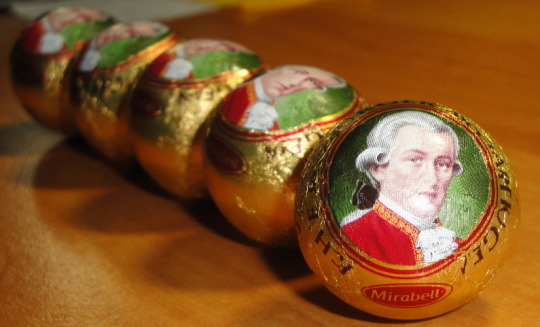
Mozart’s image has been reproduced more than any other composer in the classical world. The Mozart ‘brand’ began in the 19th century with the balls of pistachio-flavoured marzipan covered in nougat inside a layer of chocolate, known as Mozartkugeln. The most frequently reproduced portrait of Mozart was painted by Barbara Kraft, 30 years after Mozart’s death. Kraft was a well-known painter based in Salzburg and was commissioned by Joseph Sonnleithner, who created a series of portraits of well-known artists.
Whenever I’m in Austria, I always make sure that I take home some of those beautifully and elegantly packed Mozart chocolates. Of course these are not the only Mozart souvenirs you can find: look further and you’d find anything from T-shirts and key-rings to miniature musical pianos and bust statues, violin-shaped Mozart sausages and Mozart beer, as well as Mozart Christmas decorations. While I’m well aware of Mozart’s reputation and keeping in mind that he was Salzburg’s most famous son, I couldn’t help wondering what Mozart had to do with all these products.
Just to give you an idea of how serious Mozart-related things outside of the glory of classical music could get, I’ll share with you the story of Mirabell, a Salzburg-based chocolate factory owned by Kraft, which has produced 1.5 billion Mozart chocolates. The production of their main product Mozartkugeln alone is already a multi-million-dollar business. At the end of the 1970s, a dispute arose between Mirabell and Reber, a German chocolate factory, about the right to call their products the ‘real’ Mozartkugeln. Finally, an agreement was reached between representatives of both governments, which stated that only Austrian producers were allowed to use the label “Mozartkugeln”. The not-very-happy Reber protested against it and the EC Commissioner in Brussels – chief decision maker in the affair – declared the agreement invalid. To cut a long story short: Reber was permitted to legitimately and continuously use its Genuine Reber Mozart-Kugeln trademark. (God forbid that they forget to put the hyphen in between!) However only Mirabell’s Mozartkugeln are allowed to be spherical. Other Mozartkugeln must have one flat side.
Still with me? So anyway ‘selling’ Mozart has become a lucrative business not only in Austria, but in other countries too. One of the world’s top 50 brands, the name Mozart is appraised to be worth $5 billion in annual sales of products. Salzburg’s most famous native is Austria’s most successful brand worldwide, according to Arthur Oberascher, director of the Austrian Tourist Bureau.
Again, why?
Of course we can understand that the brand name ‘Mozart’ is profitable due to its high recognition value. Mozart’s life, including diaries and hundreds of letters, is heavily documented. Bearing themes such as financial concerns, anxiety and the death of his mother, those letters he wrote might as well have been part of modern gossip tabloids. Mozart understood the meaning of exposure all too well. The lack of tour buses and private jets didn’t stop Mozart from touring Europe a number of times. All this information people have gathered from him contributes to new layers of interpretation of his music. Musicologist A. Peter Brown explains that, “More than any other factor, the Mozart mania of the 1980s was initiated by Peter Shaffer’s play (and the succeeding film) Amadeus. It also enables strangers to classical music to find something that catches their interest.
The use of a personal name as a brand name will only be fruitful when a consumer recognizes the natural relationship between name and product (eg. Beyonce wearing L’Oreal lipstick and drinking Pepsi Cola). However, above all, the people of today are so obsessed with crafting their own unique identity. They do so by producing a perfect showcase of all things important to them and (so they hope) to the world. In this case, although the guy sitting next to you may not be a fan of the 41st Symphony or be bothered to see Don Giovanni even once, he’d still be happy to be associated with the genius composer in many other ways because it could mean that somewhere along the way, he is recognized by others as possessing a cultural knowledge and sophisticated taste.
With this thought in mind, I’m happy that there’s no additional explanation needed about Mozart-branded curtain fabric in China, a Mozart marketing company in the UK or a Mozart café in South Africa.
As published in primephonic on 23 January 2016